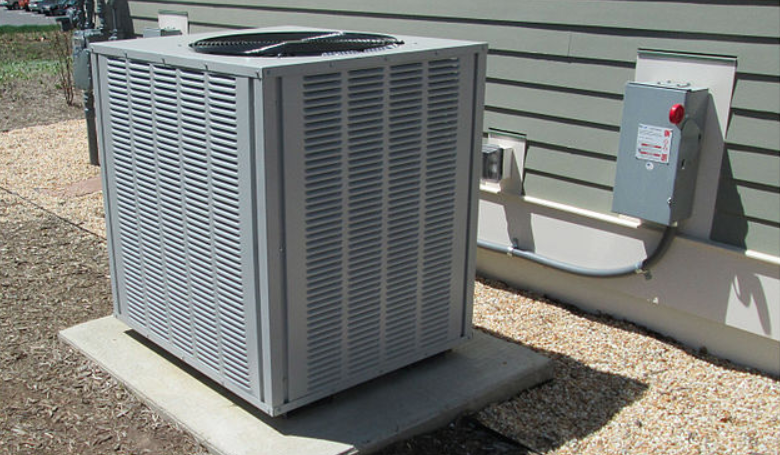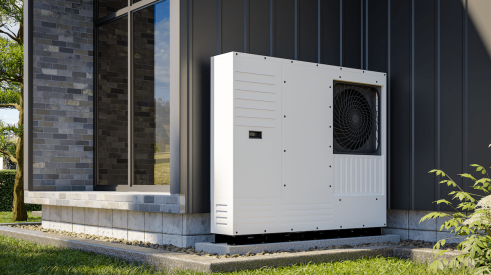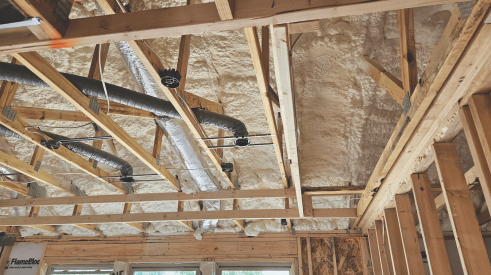Whether it’s for an energy upgrade or a new home, getting accurate heating and cooling load calculations is vitally important for HVAC system design. HVAC design impacts a home’s construction costs, comfort, air quality, durability, and energy efficiency, and HVAC load calculations will dictate the size of the HVAC system needed in a home. The consequences for choosing the wrong-sized system can be severe: noisy operation, inability to keep people comfortable, a failure to maintain proper moisture control, the breakdown of the system — even a lawsuit.
HVAC Load Calculation
Figuring a house’s load depends on a number of variables, including the climate zone, size of the house, directional orientation, tightness of the envelope, and U-value of the windows — to name a few. The many different situations HVAC designers encounter in the field can lead to confusion without some guidance on how to handle them.
IBACOS, a building science research and consulting organization and Building America team leader, recently presented a webinar in partnership with the U.S. Department of Energy’s Building Technologies program that dealt with the key criteria required to get accurate heat load calculations and cooling load calculations. This is the first of a series of webinars dealing with right-sizing HVAC systems available through IBACOS' Housing Innovation Alliance).
Here are some tips for ensuring reliable HVAC load calculation numbers, so grab your Air Conditioning Contractors of America (ACCA) Manual J Version 8 and let’s take a look:
1. Put those thumbs away
If you’re an experienced home builder or HVAC design professional, you may question the importance of running all those calculations needed to get accurate heating/cooling loads, since rules of thumb have served you well so far. Over the last 10 or 15 years, code requirements have risen in most states and will continue to rise for at least the next few years, and while home construction and code requirements have changed, rules of thumb like “x number of square feet per ton” haven’t.
With oil and gas prices climbing, more homeowners are updating their homes with better insulation, tighter windows, and other improvements. The energy upgrades translate to rooms with much lower loads, less infiltration, and higher retained moisture. When a home’s airtightness and insulation values rise, its peak heating and cooling loads fall. The more high-performing the home, the smaller its heating and cooling loads will be. The time when old rules of thumb were enough is over — and it’s not coming back.
2. Get the right information up front
It’s vitally important to have all of the specifications and plans for the house you’re designing the HVAC system for. If there are holes in the numbers you need, make sure you track them down or test to obtain them. This may include doing walkthroughs of homes of similar construction to help you understand what you’re dealing with in terms of HVAC load calculations. For example, say you do a walkthrough of a home and discover that an attic knee wall doesn’t include draft-stopping; This is going to change your calculations.
There are a number of issues with performing accurate HVAC load calculations on existing homes for an energy upgrade, but the accuracy of the estimate depends upon getting as much correct information as possible. Manual J addresses these uncertainties and offers guidance in Sections 18-24 and Appendices 2, 5, and 6.
RELATED
- Access the “Strategy Guideline: Accurate Heating and Cooling Load Calculations” on the IBACOS website
- Watch the “What’s New” section of the Alliance website for more details on upcoming webinars
- Getting HVAC Right: Consider These Tips When Sizing and Specifying
3. When in doubt, test
Say you don’t have the information you need or are unsure of the accuracy of the estimated R-value and infiltration value of the enclosure. As I mentioned above, one option is to test a similar house under construction to get the data. Similarly, if you are performing an energy upgrade on an existing home and are missing information about the insulation and infiltration values for the enclosure, it’s time to test. Blower-door tests can provide information on air-infiltration rates. For insulation, you can drill a hole and drop a camera probe in to have a look.
4. Make good use of your tools
Use your Manual J procedures faithfully and exactly. Have a hard copy near you when you’re doing your HVAC load calculations and refer to it often. Also, the ACCA procedures have been written into commercial software packages to help designers work through the iterations required for a good design. But keep in mind that while commercial software is an important tool for design, it should be operated with a solid understanding of the procedures of design. Again, accuracy is key. Since the load calculations are the first step in an iterative HVAC design process, you can’t afford to have them be wrong. The HVAC load calculations are used to find the right equipment size with ACCA Manual S, and used to figure the proper air-distribution system and ductwork in ACCA Manuals T and D. If your load calculations are wrong, the rest of the design will also be wrong.
5. Change one thing in an HVAC system and you’ve changed the entire system
At a higher level, since the individual systems within a house are interdependent, the impacts of HVAC changes on the durability of the enclosure, for example, can also be huge (see tip No. 6). Designers may think they’re doing their clients and themselves a favor by using worst-case scenarios and over-estimating their load calculations. But “fudging” the numbers a bit on one end can work out to big errors in choosing system size.
IBACOS’ “Guide to Heating and Cooling Load Calculations in High Performance Homes,” produced for the Building America program, proved this by taking baseline HVAC load calculations on two hypothetical homes — one in Chicago and another in Florida — and running several possible “safety factors,” manipulating data such as outdoor/indoor design conditions, building components, and ductwork conditions. We then added them all together in one big worst-case scenario. The results were telling: a 1.5-ton cooling system oversize for the Chicago house and a whopping 3-ton cooling system oversize for the Florida house. Trust your numbers and the size of system they dictate.
6. Beware of the short-cycle with your HVAC system
So what if the heating or cooling system of a house is oversized? A little extra horsepower serves as insurance, right? Wrong. In order to reach peak operational efficiency, a system has to run as long as possible to meet loads. An oversized HVAC system tends to short-cycle, leading to several possible risks:
- Higher operational costs resulting from inefficient use of energy and wear and tear on the equipment, causing possible failure.
- Air in the ducts fails to maintain a consistent temperature, leading to occupant discomfort and frequent thermostat adjustments.
- Inadequate removal of moisture from the air, leaving the home uncomfortably damp and a possible breeding ground for mold. This is one of those things about HVAC system design that isn’t necessarily intuitive — a system performs better when it runs longer.
7. Don’t lose sight of the three keys when calculating HVAC loads
There are three main factors to be considered when calculating loads, and you need to be sure to address them all:
A. Design considerations. These are the location, house size, and outdoor and indoor design conditions of the house and include such things as relative humidity, latitude, elevation, and directional orientation of the house. Keep in mind that a house in the same climate or city, even of the same house plan, doesn’t necessarily have the same heating and cooling loads — solar gain plays a large part in cooling loads.
B. Thermal enclosure. This includes the windows’ U-values, the home’s insulation values and airtightness, and external and internal shading. Just in considering a home’s windows, you need to take into account their orientation, size, thermal conductivity, and solar heat gain coefficient. The better a home’s enclosure, the more the windows are going to affect the loads.
C. Internal loads. These include the number of people living in the home, their electronics, lighting and appliances, and system location and ductwork. A system where the ducts pass through a very hot, uninsulated attic will work out to have different loads than one where the ducts pass through a highly insulated attic.
Click for more at IBACOS.
Advertisement
Related Stories
Awards
6th Annual MVP Awards: HVAC
The Most Valuable Product Awards showcase the best in new building product design, innovation, and functionality. Here are the winners in the HVAC category
HVAC
5 Findings About Heat Pumps
Pinpointing whether heat pumps are a good investment is tricky. A recent report from the National Renewable Energy Lab aims to cut through the complexity
Quality Matters
Tips for Placing HVAC Ducts in Conditioned Space
See how putting HVAC ducts inside conditioned space in a home benefits both the builder and the homeowner







